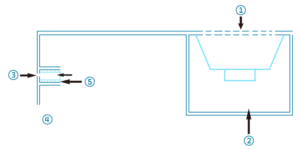Echo Cancellation
When we’re using hands-free applications or doing conference calls, microphones are deployed to receive local sound, and speakers to play out remote sound. This is called duplex system where microphones and speakers are simultaneously working together. Echo issues might arise as the remote sound coming from the speaker might be captured as local sound by the microphone, which can cause noise trouble.
Echo might come along with howling problem. Echo describes the sound output inadvertently recorded back to the input, and repeating itself in a gradually attenuated loop of echo. Howling is a screeching beep that occurs dramatically when echo is present. The frequency of this feedback noise is typically between 200hz and 4,000hz. Thus, it’s important to cancel out either the echo or howling. This method is usually termed Acoustic Echo Cancelling (AEC)
There’re a few ways to do AEC.
1. Electrical
Currently echo is mainly solved electrically. This warrants the use of AEC software or separate DSPs.
- Full duplex
The output electrical signal is used to cancel out a portion of the microphone input signal. The electrical signal will be slightly different from the playback sound in the real world, as the playback will be colored by the speaker’s frequency response and the environment’s impulse response. The AEC algorithm has to accommodate for this. Some ICs achieving full duplex are for example ALC880 and FM2018, which are expensive.
- Half duplex
The microphone instantly cuts off recording when the speaker is playing. This of course gets rids of echo but then the microphone and the speaker cannot work simultaneously. This is the same mechanism used in traditional walkie-talkies, with the advantage of cost efficiency and ease of design. Some ICs achieving half duplex are for example.
2. Mechanical isolation
Electrical AEC is best complemented with mechanical isolation. There’re several key points to follow.
- The back volume of the speaker must be sealed as tightly as possible. It will be disastrous if the back sound of the speaker travels to the front. The reason is AEC is suited to detect front sound, not from the back, which has phase differences.
- Physical cushioning.
Cushioning methods include connecting the speaker and microphone with flexible PCB, instead of typical PCB. It’s because the traditional PCB’s material is so hard that echo can be easily transmitted via vibration transduction. Another way is to assemble the speaker and microphone on separate PCBs, which separates vibration more completely. Furthermore, some cushioning material should surround the microphone, for example rubber holders. AATC advises on the thickness, softness and geometry of such holders. Apart from rubber, we can also apply silicon, eva sponge and others. Eva absorbs vibration effectively but the downside is it’s not perfectly waterproof. Moreover, softer sponge can take in more impact but unfortunately it’s air-tightness becomes weaker.

